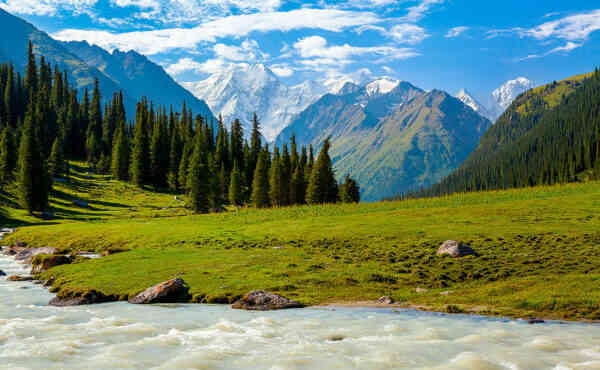The country of Kyrgyzstan, is really beautiful and interesting. Located almost in the heart of Asia, it is distinguished by amazing nature, picturesque mountains, deep lakes and sharp seasonal climate changes – this is a consequence of its geographical location. Lovers of beaches and «all-inclusive» hotels do not come here, but having been here at least once, it is easy to leave your heart here.
Facts about Kyrgyzstan
- The country’s capital, Bishkek, is its largest city. The population here in 2019 exceeded one million people.
- Among all the CIS countries, Kyrgyzstan ranks 7th in terms of area.
- Kyrgyzstan is most likely the birthplace of walnuts.
- Bishkek in the Soviet era was at one time called «Frunze». At the same time, the Soviet authorities did not take into account that the sound «f» not in the Kyrgyz language, and the city was called «Prunze».
- Once upon a time, the path of the famous Alexander the Great ran through the territory of modern Kyrgyzstan (interesting facts about Alexander the Great).
- The Kyrgyz language is the state language in Kyrgyzstan, but Russian also has official status.
- Cosmonauts claim that from near-Earth orbit, the famous Kyrgyz lake Issyk-Kul resembles a human eye.
- A unique endemic subspecies of «moonflower» grows in Kyrgyzstan, which is called here «aigul». Moreover, it grows only on one slope of Mount Aigultash.
- In the center of Bishkek, under Ala-Too Square, there is an underground bunker built as a shelter for local authorities during the Soviet era. Now you can even visit it, it hosts various exhibitions from time to time.
- It is in Kyrgyzstan that the largest walnut and fruit forests in the world are located. In the valley of the picturesque river Arslanbob, they occupy an area of about 600,000 hectares.
- There is a unique Merzbacher lake here. Nestled between two mountain ranges, it appears and disappears. Attempts to understand the nature of this phenomenon have not yet yielded results.
- Kyrgyzstan has no access to the sea. It is surrounded on all sides by China, Uzbekistan, Tajikistan and Kazakhstan (interesting facts about Kazakhstan).
- Kyrgyzstan is home to the aforementioned Issyk-Kul Lake, the second largest salt lake in the world (and the sixth deepest of all lakes). The first place belongs to the Caspian Sea, which is de facto a lake.
- On one of the Kyrgyz glaciers, we managed to find arrows perfectly preserved due to the cold, made primitive hunters many thousands of years ago.
- Kumiss is a very popular drink in Kyrgyzstan. It is prepared from horse milk.
- Never melting glaciers occupy about 4% of the territory of Kyrgyzstan.
- Here, as in Mongolia, there are still real nomads. They live in yurts and follow their herds.
- The transparency of water in Issyk-Kul is second only to the transparency of Baikal (interesting facts about Baikal). And this lake is also connected to the Pacific Ocean by a system of underground rivers.
- Mountains occupy about 90% of the territory of Kyrgyzstan.
- Pobeda Peak in Kyrgyzstan is the northernmost mountain in the world among those with a height of more than 7 kilometers above sea level.
- Kyrgyz coins are minted in Kazakhstan, and banknotes are printed in Malta and France.
- On the shore of Issyk-Kul is a villa that once belonged to Fidel Castro, the leader Cuban Revolution.
- Kyrgyzstan is home to Kumtor, a high-altitude gold deposit second in height only to the Yanacocha deposit in Peru. Kumtor lies at an altitude of more than 4 km above sea level.
- In total, more than 3,500 plant species grow on the territory of Kyrgyzstan.
- The number of tourists visiting Kyrgyzstan annually is approximately equal to the population of this country.
- Kyrgyzstan owns the world’s only high-mountain military fleet
